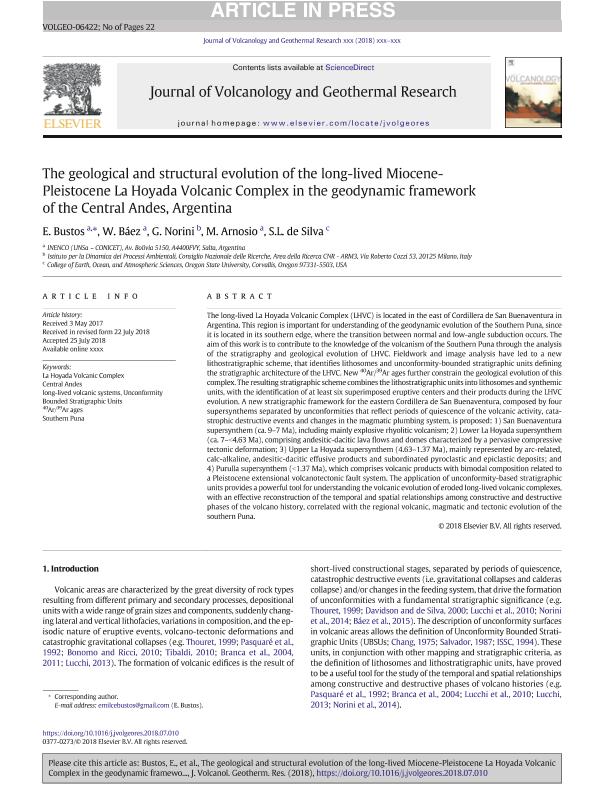Artículo
The geological and structural evolution of the long-lived Miocene-Pleistocene La Hoyada Volcanic Complex in the geodynamic framework of the Central Andes, Argentina
Fecha de publicación:
07/2018
Editorial:
Elsevier Science
Revista:
Journal of Volcanology and Geothermal Research
ISSN:
0377-0273
Idioma:
Inglés
Tipo de recurso:
Artículo publicado
Clasificación temática:
Resumen
The long-lived La Hoyada Volcanic Complex (LHVC) is located in the east of Cordillera de San Buenaventura in Argentina. This region is important for understanding of the geodynamic evolution of the Southern Puna, since it is located in its southern edge, where the transition between normal and low-angle subduction occurs. The aim of this work is to contribute to the knowledge of the volcanism of the Southern Puna through the analysis of the stratigraphy and geological evolution of LHVC. Fieldwork and image analysis have led to a new lithostratigraphic scheme, that identifies lithosomes and unconformity-bounded stratigraphic units defining the stratigraphic architecture of the LHVC. New 40Ar/39Ar ages further constrain the geological evolution of this complex. The resulting stratigraphic scheme combines the lithostratigraphic units into lithosomes and synthemic units, with the identification of at least six superimposed eruptive centers and their products during the LHVC evolution. A new stratigraphic framework for the eastern Cordillera de San Buenaventura, composed by four supersynthems separated by unconformities that reflect periods of quiescence of the volcanic activity, catastrophic destructive events and changes in the magmatic plumbing system, is proposed: 1) San Buenaventura supersynthem (ca. 9?7 Ma), including mainly explosive rhyolitic volcanism; 2) Lower La Hoyada supersynthem (ca. 7?<4.63 Ma), comprising andesitic-dacitic lava flows and domes characterized by a pervasive compressive tectonic deformation; 3) Upper La Hoyada supersynthem (4.63?1.37 Ma), mainly represented by arc-related, calc-alkaline, andesitic-dacitic effusive products and subordinated pyroclastic and epiclastic deposits; and 4) Purulla supersynthem (<1.37 Ma), which comprises volcanic products with bimodal composition related to a Pleistocene extensional volcanotectonic fault system. The application of unconformity-based stratigraphic units provides a powerful tool for understanding the volcanic evolution of eroded long-lived volcanic complexes, with an effective reconstruction of the temporal and spatial relationships among constructive and destructive phases of the volcano history, correlated with the regional volcanic, magmatic and tectonic evolution of the southern Puna.
Archivos asociados
Licencia
Identificadores
Colecciones
Articulos(INENCO)
Articulos de INST.DE INVEST.EN ENERGIA NO CONVENCIONAL
Articulos de INST.DE INVEST.EN ENERGIA NO CONVENCIONAL
Citación
Bustos, Emilce; Baez, Walter Ariel; Norini, Gianluca; Arnosio, José Marcelo; de Silva, Shanaka; The geological and structural evolution of the long-lived Miocene-Pleistocene La Hoyada Volcanic Complex in the geodynamic framework of the Central Andes, Argentina; Elsevier Science; Journal of Volcanology and Geothermal Research; 7-2018; 1-22
Compartir
Altmétricas




